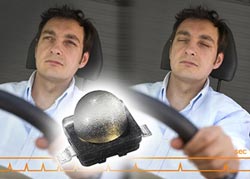Infrared LED Detects Drivers in Microsleep

In addition to the IR-LED, this requires a suitable camera with a CMOS sensor. The sensor detects IR light at a wavelength of 850 nanometers, which isn't visible to the human eye, and analyzes the image of the driver that is captured by the camera. And it all takes place unnoticed by the driver – even at night.
The camera, which is mounted in the driver's field of vision, uses image analysis software to determine if the driver is fatigued or distracted. Thanks to its small size and integrated lens, which has a 40-degree angle of illumination, the SFH4236 type LED can be easily installed in the dashboard of a vehicle, for example, and directly illuminate the driver from the front, without producing shadows.
IR-LEDs of this output class with integrated lenses have not been available until now. According to German Traffic Safety Advisory Board statistics, about 1,300 people are killed in single-vehicle accidents on Germany's roads every year – accidents involving no other road users.
It is estimated that at least 25 percent of these accidents are caused by microsleep. The fatigue detection system featuring the IR-LED from Osram Opto Semiconductors could become a lifesaver in such cases.
Other areas of application for such high-performance IR-LEDs in motor vehicles include seat occupancy recognition, night vision systems, short-range surroundings detection, and monitoring drivers' blind spots. The IR-LED has a service life of tens of thousands of hours, many times more than the average number of hours that a vehicle is operated in its service life. In other words, it will never have to be replaced during the average life of a vehicle.
Media Contact
More Information:
http://www.siemens.com/innovationnewsAll latest news from the category: Power and Electrical Engineering
This topic covers issues related to energy generation, conversion, transportation and consumption and how the industry is addressing the challenge of energy efficiency in general.
innovations-report provides in-depth and informative reports and articles on subjects ranging from wind energy, fuel cell technology, solar energy, geothermal energy, petroleum, gas, nuclear engineering, alternative energy and energy efficiency to fusion, hydrogen and superconductor technologies.
Newest articles

Trotting robots reveal emergence of animal gait transitions
A four-legged robot trained with machine learning by EPFL researchers has learned to avoid falls by spontaneously switching between walking, trotting, and pronking – a milestone for roboticists as well…

Innovation promises to prevent power pole-top fires
Engineers in Australia have found a new way to make power-pole insulators resistant to fire and electrical sparking, promising to prevent dangerous pole-top fires and reduce blackouts. Pole-top fires pose…

Possible alternative to antibiotics produced by bacteria
Antibacterial substance from staphylococci discovered with new mechanism of action against natural competitors. Many bacteria produce substances to gain an advantage over competitors in their highly competitive natural environment. Researchers…





















